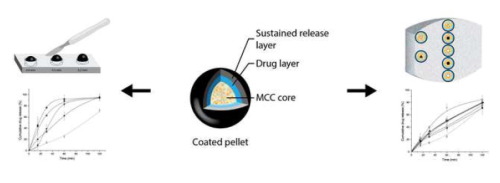当前位置:
X-MOL 学术
›
Eur. J. Pharm. Biopharm.
›
论文详情
Our official English website, www.x-mol.net, welcomes your
feedback! (Note: you will need to create a separate account there.)
A mechanistic understanding of compression damage to the dissolubility of coated pellets in tablets.
European Journal of Pharmaceutics and Biopharmaceutics ( IF 4.4 ) Pub Date : 2019-11-28 , DOI: 10.1016/j.ejpb.2019.11.006 Tze Ning Hiew 1 , Yu Harn Tian 1 , Huei Ming Tan 2 , Paul Wan Sia Heng 1
European Journal of Pharmaceutics and Biopharmaceutics ( IF 4.4 ) Pub Date : 2019-11-28 , DOI: 10.1016/j.ejpb.2019.11.006 Tze Ning Hiew 1 , Yu Harn Tian 1 , Huei Ming Tan 2 , Paul Wan Sia Heng 1
Affiliation

|
Damage to the drug diffusion coat barrier of controlled release pellets by the compaction force when preparing multiple-unit pellet system tablets is a major concern. Previous studies have shown that pellets located at the tablet axial and radial peripheral surfaces were more susceptible to damage when compacted due to the considerable shear encountered at these locations. Hence, this study was designed to assess with precision the impact of pellet spatial position in the compact on the extent of coat damage by the compaction force via a single pellet in minitablet (SPIM) system. Microcrystalline cellulose (MCC) pellet cores were consecutively coated with a drug layer followed by a sustained release layer. Chlorpheniramine maleate was the model drug used. Using a compaction simulator, the coated pellets were compacted singly into 3 mm diameter SPIMs with MCC as the filler. SPIMs with individual pellets placed in seven positions were prepared. The uncompacted and compacted coated pellets, as SPIMs, were subjected to drug release testing. The dissolution results showed that pellets placed at the top-radial position were the most susceptible to coat damage by the compaction force, while pellets positioned within the minitablet at the middle and upper quadrant positions showed the least damage. The SPIM system was found to be effective at defining the extent of coat damage to the pellet spatial position in the compact. This study confirmed that coated pellets located at the periphery were more susceptible to damage by compaction, with pellets located at the top-radial position showing the greatest extent of coat damage. However, if the pellet was completely encrusted by the cushioning filler, coat damage could be mitigated. Further investigations were directed at how the extent of coat damage impacted drug release. Interestingly, small punctures were found to be most detrimental to drug release whilst coats with large surface cuts did not completely fail. A damaged pellet coat has some self-sealing ability and failure is not total. Thus, this study provides a deeper understanding of the consequence of coat damage to drug release when sustained release coated pellets are breached.
中文翻译:

压缩损伤对片剂中包衣小丸溶解性的机械理解。
当制备多单位丸剂系统片剂时,由于压紧力对控释药丸的药物扩散涂层屏障的损害是一个主要问题。先前的研究表明,由于在这些位置遇到的相当大的剪切力,压实时位于片剂轴向和径向外围表面的药丸更容易受到破坏。因此,本研究旨在通过微型片剂(SPIM)系统中的单个颗粒,精确评估压坯中颗粒空间位置对压实力对涂层破坏程度的影响。微晶纤维素(MCC)药丸核心依次被药物层和持续释放层包裹。马来酸氯苯那敏是使用的模型药物。使用压缩模拟器 用MCC作为填充剂,将包衣的丸粒单独压成3mm直径的SPIM。制备了具有放置在七个位置的单个颗粒的SPIM。将未压实和压实的包衣药丸(即SPIM)进行药物释放测试。溶出度结果表明,位于顶部径向位置的丸粒最容易受到压紧力的破坏,而位于微型平板中,位于上象限和上象限位置的丸粒受到的损伤最小。发现SPIM系统可有效地确定包衣对压坯中颗粒空间位置的损害程度。这项研究证实,位于边缘的包衣颗粒更容易受到压实的破坏,位于顶部径向位置的颗粒显示出最大程度的涂层损伤。然而,如果颗粒被缓冲填料完全包住,则可以减轻涂层损坏。进一步的研究针对外套损害的程度如何影响药物释放。有趣的是,发现小刺孔对药物释放最有害,而具有大表面切口的涂层并没有完全失效。破损的颗粒涂层具有一定的自密封能力,并且不会完全失败。因此,本研究对突破缓释包衣药丸的包衣损害药物释放的后果提供了更深入的了解。发现小刺孔对药物释放最有害,而具有大表面切口的涂层并没有完全失效。破损的颗粒涂层具有一定的自密封能力,并且不会完全失败。因此,本研究对突破缓释包衣药丸的包衣损害药物释放的后果提供了更深入的了解。发现小刺孔对药物释放最有害,而具有大表面切口的涂层并没有完全失效。破损的颗粒涂层具有一定的自密封能力,并且不会完全失败。因此,本研究对突破缓释包衣药丸的包衣损害药物释放的后果提供了更深入的了解。
更新日期:2019-11-29
中文翻译:

压缩损伤对片剂中包衣小丸溶解性的机械理解。
当制备多单位丸剂系统片剂时,由于压紧力对控释药丸的药物扩散涂层屏障的损害是一个主要问题。先前的研究表明,由于在这些位置遇到的相当大的剪切力,压实时位于片剂轴向和径向外围表面的药丸更容易受到破坏。因此,本研究旨在通过微型片剂(SPIM)系统中的单个颗粒,精确评估压坯中颗粒空间位置对压实力对涂层破坏程度的影响。微晶纤维素(MCC)药丸核心依次被药物层和持续释放层包裹。马来酸氯苯那敏是使用的模型药物。使用压缩模拟器 用MCC作为填充剂,将包衣的丸粒单独压成3mm直径的SPIM。制备了具有放置在七个位置的单个颗粒的SPIM。将未压实和压实的包衣药丸(即SPIM)进行药物释放测试。溶出度结果表明,位于顶部径向位置的丸粒最容易受到压紧力的破坏,而位于微型平板中,位于上象限和上象限位置的丸粒受到的损伤最小。发现SPIM系统可有效地确定包衣对压坯中颗粒空间位置的损害程度。这项研究证实,位于边缘的包衣颗粒更容易受到压实的破坏,位于顶部径向位置的颗粒显示出最大程度的涂层损伤。然而,如果颗粒被缓冲填料完全包住,则可以减轻涂层损坏。进一步的研究针对外套损害的程度如何影响药物释放。有趣的是,发现小刺孔对药物释放最有害,而具有大表面切口的涂层并没有完全失效。破损的颗粒涂层具有一定的自密封能力,并且不会完全失败。因此,本研究对突破缓释包衣药丸的包衣损害药物释放的后果提供了更深入的了解。发现小刺孔对药物释放最有害,而具有大表面切口的涂层并没有完全失效。破损的颗粒涂层具有一定的自密封能力,并且不会完全失败。因此,本研究对突破缓释包衣药丸的包衣损害药物释放的后果提供了更深入的了解。发现小刺孔对药物释放最有害,而具有大表面切口的涂层并没有完全失效。破损的颗粒涂层具有一定的自密封能力,并且不会完全失败。因此,本研究对突破缓释包衣药丸的包衣损害药物释放的后果提供了更深入的了解。











































 京公网安备 11010802027423号
京公网安备 11010802027423号